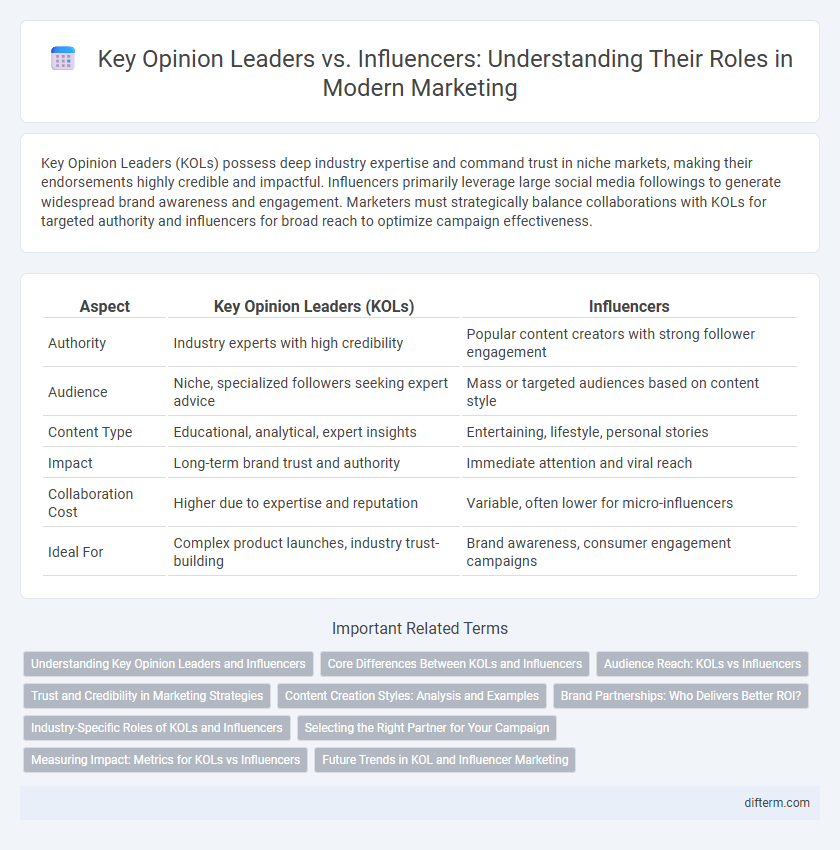Key Opinion Leaders (KOLs) possess deep industry expertise and command trust in niche markets, making their endorsements highly credible and impactful. Influencers primarily leverage large social media followings to generate widespread brand awareness and engagement. Marketers must strategically balance collaborations with KOLs for targeted authority and influencers for broad reach to optimize campaign effectiveness.
Table of Comparison
| Aspect | Key Opinion Leaders (KOLs) | Influencers |
|---|---|---|
| Authority | Industry experts with high credibility | Popular content creators with strong follower engagement |
| Audience | Niche, specialized followers seeking expert advice | Mass or targeted audiences based on content style |
| Content Type | Educational, analytical, expert insights | Entertaining, lifestyle, personal stories |
| Impact | Long-term brand trust and authority | Immediate attention and viral reach |
| Collaboration Cost | Higher due to expertise and reputation | Variable, often lower for micro-influencers |
| Ideal For | Complex product launches, industry trust-building | Brand awareness, consumer engagement campaigns |
Understanding Key Opinion Leaders and Influencers
Key Opinion Leaders (KOLs) hold authoritative expertise within specific industries, influencing target audiences through trusted knowledge and credibility. Influencers primarily leverage their broad social media presence and engagement metrics to sway consumer behavior and brand perception. Understanding the distinct roles and impact metrics of KOLs versus influencers enables marketers to tailor strategies for authentic brand endorsement and optimized audience reach.
Core Differences Between KOLs and Influencers
Key Opinion Leaders (KOLs) possess deep expertise and credibility within specialized industries, while influencers primarily leverage their follower count and social media presence to shape consumer behavior. KOLs often influence professional or niche markets through authoritative knowledge, whereas influencers engage broader audiences with relatable content and lifestyle appeal. Brand collaborations with KOLs tend to emphasize trust and informed endorsements, contrasting with influencers' focus on visibility and trend-driven impact.
Audience Reach: KOLs vs Influencers
Key Opinion Leaders (KOLs) typically have a smaller but highly engaged and specialized audience, offering deep influence within niche markets. Influencers often boast a larger, more diverse follower base across various social media platforms, enabling broader but sometimes less targeted reach. Brands seeking precise audience targeting and credibility prioritize KOLs, while those aiming for mass awareness lean towards influencers for their expansive audience reach.
Trust and Credibility in Marketing Strategies
Key Opinion Leaders (KOLs) hold higher trust and credibility in marketing strategies due to their expertise and authoritative voice in specific industries, resulting in more impactful brand endorsements. Influencers often have broader but less specialized audiences, making their recommendations less trusted for expert-driven products or services. Leveraging KOLs enhances brand reputation and customer confidence, driving stronger engagement and conversion rates in targeted marketing campaigns.
Content Creation Styles: Analysis and Examples
Key Opinion Leaders (KOLs) typically produce in-depth, authoritative content grounded in expertise, often featuring detailed reviews, case studies, and industry insights, which foster trust and credibility among niche audiences. Influencers focus on engaging, visually appealing, and relatable content styles such as lifestyle vlogs, short-form videos, and interactive stories designed to drive high engagement and brand awareness across broader demographics. Brands leverage KOLs for informed, expert-driven campaigns while influencers are favored for dynamic, trend-driven promotions that resonate with diverse online communities.
Brand Partnerships: Who Delivers Better ROI?
Key Opinion Leaders (KOLs) typically offer higher ROI in brand partnerships due to their industry expertise, trusted authority, and deep audience engagement, which drives more authentic and lasting consumer influence. Influencers, while able to reach larger and more diverse audiences quickly, often deliver shorter-term bursts of engagement that may not convert into sustained brand loyalty. Brands aiming for long-term value and credibility favor KOL collaborations, leveraging their targeted niche impact and influence quality over quantity.
Industry-Specific Roles of KOLs and Influencers
Key Opinion Leaders (KOLs) possess deep expertise and credibility within specific industries, making their endorsements highly trusted by niche audiences, while influencers often have broader appeal driven by their social media presence. KOLs are typically professionals such as doctors, scientists, or industry analysts whose opinions shape industry trends and product credibility. Influencers prioritize engagement and reach, leveraging personal branding to impact consumer behavior across diverse markets but may lack specialized authority in a given field.
Selecting the Right Partner for Your Campaign
Selecting the right partner for your marketing campaign depends on aligning brand values with the influence type; Key Opinion Leaders (KOLs) offer niche expertise and credibility in specific industries, driving trust and long-term engagement. Influencers provide broader reach and social media presence, ideal for campaigns targeting mass awareness and trending topics. Evaluating metrics such as audience demographics, engagement rates, and content relevance ensures optimal campaign impact and ROI.
Measuring Impact: Metrics for KOLs vs Influencers
Key Opinion Leaders (KOLs) impact is measured through metrics such as audience trust level, industry relevance, and conversion rates within niche markets, highlighting their expertise-driven influence. Influencers are assessed using follower count, engagement rate, impressions, and social media reach, emphasizing broad appeal and brand visibility. Understanding these distinct metrics allows marketers to tailor strategies effectively by leveraging KOLs for targeted authority and influencers for mass audience engagement.
Future Trends in KOL and Influencer Marketing
Key Opinion Leaders (KOLs) and influencers are evolving with increased emphasis on authenticity, data-driven strategies, and niche audience engagement in marketing. Future trends indicate a rise in micro and nano KOLs leveraging deep expertise to build trust, while influencer marketing integrates AI for precision targeting and performance analytics. Brands are shifting towards long-term partnerships with KOLs and influencers who demonstrate genuine alignment with their values and provide measurable ROI.
Key Opinion Leaders vs Influencers Infographic

 difterm.com
difterm.com